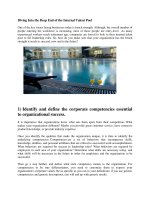Navigating the talent shift
Bạn đang xem bản rút gọn của tài liệu. Xem và tải ngay bản đầy đủ của tài liệu tại đây (4.95 MB, 160 trang )
,
Navigating the Talent Shift
Lisa Hufford
Navigating the Talent Shift
How to Build On-Demand Teams
that Drive Innovation, Control Costs,
and Get Results
Lisa Hufford
Simplicity Consulting
Kirkland, Washington, USA
ISBN 978-1-137-54803-0
ISBN 978-1-137-54802-3
DOI 10.1057/978-1-137-54802-3
(eBook)
Library of Congress Control Number: 2016945576
© The Editor(s) (if applicable) and The Author(s) 2016
This work is subject to copyright. All rights are solely and exclusively licensed by the Publisher, whether
the whole or part of the material is concerned, specifically the rights of translation, reprinting, reuse of
illustrations, recitation, broadcasting, reproduction on microfilms or in any other physical way, and transmission or information storage and retrieval, electronic adaptation, computer software, or by similar or
dissimilar methodology now known or hereafter developed.
The use of general descriptive names, registered names, trademarks, service marks, etc. in this publication
does not imply, even in the absence of a specific statement, that such names are exempt from the relevant
protective laws and regulations and therefore free for general use.
The publisher, the authors and the editors are safe to assume that the advice and information in this book
are believed to be true and accurate at the date of publication. Neither the publisher nor the authors or the
editors give a warranty, express or implied, with respect to the material contained herein or for any errors
or omissions that may have been made.
Printed on acid-free paper
This Palgrave Macmillan imprint is published by Springer Nature
The registered company is Nature America Inc. New York
For my supportive and loving husband, David, and our beautiful
boys, Jack and Ian. You inspire me to live an authentic and
purpose-driven life.
Contents
Acknowledgments
ix
Introduction
xi
Chapter 1 Navigating the Shifts in the On-Demand Workplace
1
Chapter 2 The Changing Face of Talent
17
Chapter 3 The SPEED Solution
37
Chapter 4 Build Your On-Demand Team
57
Chapter 5 Overcoming Roadblocks and Perceptions
95
Chapter 6 A Start-Up Within a Corporation
115
Chapter 7 An Innovative Idea That Launched a $100 Million
Business
121
Chapter 8 Orchestrating a Global Transformation
with On-Demand Experts
127
Chapter 9 Conclusion
135
Resource Guide
139
Index
147
Acknowledgments
T
his book is a true collective effort of so many talented
people who I have been fortunate to know and work
with.
I have been able to develop my expertise because of the thousands of consultants and clients whom I have had the honor
of listening to, coaching, advising, and learning from in the
course of growing my business. I am grateful to all of you who
contributed your time and experiences to this book so that
other professionals can learn from your wisdom.
Thank you to the entire Simplicity Consulting staff, who
have shared their vision with me and shown their commitment to providing an exceptional customer experience in every
conversation and interaction. Specifically, thank you, Carrie
Morris. You have been my chief cheerleader, motivator, and
strategic doer at Simplicity Consulting. Nobody thinks bigger
than you, and you believed in the idea of this book even before
I did. Your contagious enthusiasm infects everyone you interact
with, and I am grateful for your shared vision, brainstorming
sessions, and passion to continue to do more and better.
Special thanks to the many previous managers who have
shaped, enabled, and supported my growth and development
over the 20+ years of my working life. I am fortunate to have
x
●
Acknowledgments
learned valuable leadership lessons from each of them and am
grateful for the opportunities that they have provided me.
My advisors, Dr. Pamela Peeke and Rick Wong, for their
unwavering confidence in me, for having my back, offering
advice and their broad perspective.
My brand strategist and writer, Elizabeth Kanna, and writer,
William DiBenedetto, who bring the soul and narrative of my
ideas to life. Our goal was to create a practical, approachable
business book like no other, and your creative talents have
made it a reality.
Laurie Harting, executive editor at Palgrave Macmillan, for
her keen ideas and insight that have contributed to this book
being a game changer.
My business owner peers and close friends, on whom I rely
on for sanity checks and advice, and my Young Presidents’
Organization (YPO) forum for their unconditional support
and contribution to my growth as a business leader.
Academic leaders, including Sandeep Krishnamurthy of
Dean Business School UW Bothell, and Scott Dawson of Dean
Business School Cal Poly San Luis Obispo, for their unrelenting
support of entrepreneurial ideas and focus on making the world
a better place.
Thought leaders who I have never met but admire from
afar and who have shaped my thoughts and actions, including
Seth Godin, Dan Pink, Stephen Covey, Oprah Winfrey, Greg
McKeown, and Simon Sinek.
My parents for their unconditional love and support of whatever I chose to do throughout my life; they told me I could do
anything and I believed them.
My extended family and dear friends who fill my soul with
laughter and happiness.
Introduction
I
wrote Navigating the Talent Shift to help companies redefine
how to meet their business and workplace objectives, drive
innovation, and build flexible teams in a project-based environment that tap into a broader talent pool.
Companies can be more competitive and adapt faster to
changing market needs by integrating into their teams the
broad and growing base of freelancers and consultants. My
vision is that companies will expand their mindset about how
they access and acquire the talent they need to achieve the
best results in any business climate. And I believe that professionals can find significance by and success by focusing on the
work they love to do and adding value to every job.
We’re living in an on-demand world and an on-demand
economy, ranging from the movies we watch and the groceries we buy to the way we travel. Welcome to the on-demand
workplace.
My Passion for Business
My parents are retired teachers. In fact, my entire family is in
education and proud of it. I’ve always had an interest in business, even from an early age, but my parents were still surprised
when I decided to major in business at California Polytechnic
State University, where I received my Bachelor’s degree.
xii
●
Introduction
After earning my degree, I worked for 14 years in the technology sector as well as earning my Technology MBA certificate from the University of Washington. I was in supply-chain
management, and then worked for Microsoft—in sales, account
management and business development, and running global
sales teams while traveling the world. I worked for the dominant
players in their industries and was fortunate to work with leading
brands such as Apple, IBM, Sony, Toshiba, Sun Microsystems,
and Acer, to name a few. I enjoyed finding solutions, scoring
win-wins, and executing high-impact projects with large clients.
When I had my second child in 2006 something shifted for
me. I wanted to figure out how to leverage my skills so that I
could work on my own terms, and I wanted to control my own
schedule, spend more time with my family, and cut back on my
business travel.
I was in search of both a work and lifestyle change, for sure,
but I also wanted more. As anyone who’s spent time in corporate America knows, the average day at the office involves many
activities that don’t have much to do with your core competency
or job description: attending superfluous meetings, playing email
ping-pong, or being waylaid by chatty coworkers.
When I was a Director at Microsoft, for example, I had a myriad
of responsibilities, and while I didn’t mind them, they weren’t
what you’d consider “mission-critical.” I realized I also wanted to
zero in on doing more high-impact work, using a larger portion of
my time on projects that made the biggest difference for companies. To achieve those things, I approached my V.P. at Microsoft
and presented him with a plan and a description of how I could,
as a consultant, support highly strategic initiatives for the leadership team in the division. He agreed to let me transition into a
consultant role, and Microsoft was my first client. Looking back,
that was a monumental moment for me.
Introduction
●
xiii
As a consultant, I found I was able to work on projects in
ways that actually delivered more impact than I’d been able
to deliver in the role of a corporate director. This is because I
was able to give 100% of my focus to mission-critical tasks; I
didn’t have all of the other, less important responsibilities that
go along with being a company director to distract me.
Not long after my transition to consulting, I was approached by
others with similar stories—corporate professionals who wanted
more control, flexibility, and the chance to use their skills for work
that really mattered. I began teaching people how to make the
transition from a traditional FTE job to a consultant, and before
I knew it, I had a business. My business grew quickly. I identified
an emerging trend in the workforce: companies were looking
to reduce cost and risk, often by slashing talent and resources
vital to the business’s success, but they still needed experts to get
the work done. I saw an opportunity to provide companies with
a cost-effective, low-risk way to tap exceptional talent. I also
provided corporate professionals with the opportunity to do
what I did—be in control and have a choice in their lives. It was
a win-win, and I became committed to helping people find
success on their terms with their clients and consultants.
Within its first 18 months, my company, Simplicity
Consulting Inc., had 20 consultants. Since 2006, we have
successfully completed thousands of projects with a growing
community of more than 5,000 professionals. Simplicity was
named to the Inc. 5000 list for five years running as one of the
fastest-growing private companies in America. This growth is
evidence of the workplace and talent shift that’s underway.
In my work at Simplicity, I’ve helped companies such as
Amazon, Hewlett Packard, Farmers Insurance, T-Mobile, and
Microsoft create flexible teams with the on-demand experts
they need to achieve their business objectives. I’ve worked
xiv
●
Introduction
with companies as they embraced agility and leveraged the
on-demand workforce, enabling these big players to overcome
multi-million-dollar challenges, transform company-wide
legacy systems to stay relevant, and reinvigorate declining
sales channels into $100 million dollar businesses.
What This Book Covers
The first two chapters define and describe the talent shift:
Chapter 1 describes the workforce shift that’s driven by a
changing global business environment, a highly competitive
marketplace that features hyper-specialization, project-based
work, and a talent pool that aspires to—and indeed demands—
flexibility. A variety of economic, technological, and cultural
factors drives this dynamic shift. The chapter examines three
major trends that have converged to shape where we are: the
coming of age of Millennials,1 the Baby Boomers’ impact on
the workforce, and the trend that will impact about 40% of
U.S. workers by 2020, the freelance “1099 economy.”2
Chapter 2 delves deeper into the changing face of talent and
notes that by 2020, as many as 65 million Americans will be
freelancers, independent consultants and solopreneurs, making
up 40% of the workforce. The ramifications of those numbers
are enormous.
Chapters 3 and 4 introduce and describe the centerpiece of
this book: the SPEEDTM talent strategy that enables managers to
build flexible, project-based teams that get results. SPEED provides an agile and flexible framework for building on-demand
teams, and it also provides the ability to adapt to unanticipated
business changes. It encompasses the best practices that I have
learned, observed, and implemented in hundreds of projects
with every type of cost, management, and operational situation.
Introduction
●
xv
Chapter 5 outlines some common roadblocks companies may encounter when integrating SPEED within their
organizations and how to overcome them. I see roadblocks
every day—whether it is mindset, organizational, structural,
procedural, or political—and they can all be resolved.
Chapters 6, 7, and 8 feature real-world stories that show
how companies have creatively used on-demand talent to drive
innovation, control costs, and get results.
The Resource Guide provides you with additional resources,
research, and information about the talent shift and places
where you can find that talent. It also lists elements you can
use to evaluate a talent agency.
Terms and Definitions
As I note in Chap. 1, there is a great workforce shift underway, driven by a constantly changing global business environment, a highly competitive marketplace that features
hyper-specialization, project-based work, and a talent pool
that aspires to—and indeed demands—flexibility.
I define the talent shift as the emerging and broad talent
pool that’s driving a massive change to an on-demand workforce that comprises specialists, independent professionals, and
experts—however they are called—doing project-based work.
In this book, I use the term consultant most often, but I
also use the terms “experts” and “specialists” interchangeably
throughout. Talent as referred to in this book includes those
consultants, freelancers, experts, and specialists who are all in
non-FTE (full-time employee) roles.
However, the name or term for talent that are not an FTE
varies depending on the publication, the industry, company
policies, and even how a person refers to their own professional
xvi
●
Introduction
classification. For example, in their 2015 study, “Freelancing
in America,” Upwork and the Freelancers Union identified five
types of freelancers, which that year composed more than onethird of the U.S. workforce.
The Five Types of Freelancers3
1. Independent Contractors
(36% of the independent workforce/19.3 million
professionals)—These “traditional” freelancers don’t
have an employer and instead do freelance, temporary, or supplemental work on a project-to-project
basis.
2. Moonlighters
(25%/13.2 million)—Moonlighters are individuals
with a primary, traditional job with an employer who
also moonlight doing freelance work. For example, a
corporate-employed web developer who does projects
for nonprofits in the evening is a moonlighter.
3. Diversified workers
(26%/14.1 million)—Diversified workers are people
with multiple sources of income from a mix of traditional employers and freelance work. For example,
someone who works the front desk at a dentist’s office
20 hours a week and fills out the rest of his income
driving for Uber and doing freelance writing is a
diversified worker.
4. Temporary Workers
(9%/4.6 million)—Temporary workers are individuals with a single employer, client, job, or contract
project where their employment status is temporary.
For example, a data entry worker employed by a staff-
Introduction
●
xvii
ing agency and working on a three-month assignment
is a temporary worker.
5. Freelance Business Owners
(5%/2.5 million)—Freelancer business owners
have one or more employees and consider themselves
both a freelancer and a business owner. For example,
a social marketing guru who hires a team of other
social marketers to build a small agency but still identifies as a freelancer is a freelance business owner.
In some large companies a consultant is referred to as a
vendor. This is often because they are employees of an approved
supplier/provider a company uses.
Large corporations typically have formal supplier programs
that manage a list of approved suppliers and/or providers.
The providers must meet contractual obligations to be approved
and maintain a working relationship with the corporation.
I use agency in the book as a catch-all term, but qualify it
depending on whether I’m referring to large executive management or consulting agencies; marketing, advertising, or public
relations agencies; or most often, talent and specialized talent
agencies.
SPEED (see Chaps. 3 and 4) is a talent strategy that enables
managers to build flexible, project-based teams that get
results. It provides a flexible framework for on-demand teams
and the ability to adapt to unanticipated business changes
by employing five elements: Success, Plan, Execute, Evaluate,
and Decide.
Note: Company names and the people mentioned have been
changed in this book.
xviii
●
Introduction
Don’t Have a Kodak Moment
By 2020, 40% of the workforce won’t want to be a fulltime employee. You can avoid having the infamous “Kodak
moment”—when Kodak failed to see the impending disruption to the photography industry by the rise of digital
technology—by understanding what the workplace and talent
shift means for your business.
Forget the old recruit-and-search-for-months methods for
acquiring talent and the perception that “talent” is only fulltime employees.
This is why I wrote this book. To show you how to successfully navigate the talent shift that’s underway.
Notes
1. “Millennials,” Pew Research Center: research.
org/topics/millennials/. Retrieved Nov. 4, 2015.
2. Joel Kotkin, “The Rise of the 1099 Economy: More
Americans Are Becoming Their Own Bosses,” Forbes, July
25, 2012. Retrieved from economy-more
-americans-are-becoming-their-own-bosses/
3. From “Freelancing in America,” Independent study commissioned by Freelancers Union and Upwork. Released October 1,
2015. p. 6. Study retrievable for download at />e7/59e70be1-5730-4db8-919f-1d9b5024f939/survey_2015.
CHAPTER 1
Navigating the Shifts in the On-Demand
Workplace
T
he funny thing is, while I didn’t consciously seek
consulting out initially, I love what I’m doing and this
way of working. It lets me focus on doing the work I
enjoy, leaving many of the politics and workplace hassles behind.
Now, work is an activity I do, not a necessarily a place I go. It’s
refreshing and has really reinvigorated my career.
—Samantha D., Project manager/consultant
A great workforce shift is underway, driven by a constantly
changing global business environment, a highly competitive
marketplace that features hyper-specialization, project-based
work, and a talent pool that aspires to—and indeed demands—
flexibility. Business cycles have accelerated; there’s a frequent
need for fresh talent, and continuous “recruiting” has become
a big part of every manager’s job.
2
●
Navigating the Talent Shift
A variety of economic, technological, and cultural factors
drives this dynamic shift, but three major trends have converged
to shape where we are: the coming of age of Millennials,1 the
Baby Boomers’ impact on the workforce, and the trend that will
impact about 40% of U.S. workers by 2020, the freelance “1099
economy.”2 These trends gained momentum during the Great
Recession and its aftermath, emphasizing that old-school mindsets,
talent strategies, and even the definition of talent no longer work.
To illustrate, let’s start with a story.
Imagine a CEO from the 80’s is transported (by way of
magic or time travel, your choice) to modern-day Corporate
America. He finds that he’s the head of a successful business in
his industry, but he doesn’t understand this new landscape; he’s
lost as to how to operate in it. The technology both alarms and
confuses him. In a panic, he issues a company-wide memorandum
ordering that all work must be done on technology from the
’80s, telling himself that since it worked for him in the past,
he’ll make it work now.
Instead of laptops and smartphones, employees are left to
handle daily communications using typewriters or clunky
DOS computers that only do basic word processing—on a
dark green screen with a blinking green cursor. And instead of
cloud storage and officewide networks that make collaboration
easy and backup reliable, everything is put on floppy discs that
must be traded back and forth if more than one person wants
to work on the same file.
Anyone who leaves the office must find a payphone if they
need to call in to check their messages, find out why they’ve
Navigating the Shifts in the On-Demand Workplace
●
3
been paged (remember pagers? or payphones, for that matter?),
or get directions if they have lost their way to a big meeting. If
anyone outside the company needs to communicate information, it must come in via fax, mail, or courier. When someone
needs to look up basic information, it’s time to head to the
library and the microfiche machine.
How long do you think this business would remain successful? How well do you think any of its employees would be able
to do their jobs, even if they were well-regarded hotshots in
their industry?
Yes, this is a ridiculous scenario. I’ve made it as extreme and
far-fetched as possible to illustrate the point that the best and
most successful companies, leaders, and managers must evolve
and adapt with the times. They recognize when their “timetested” strategies, business models, and “best practices” have
become outdated or insufficient, and they’re willing to invest
the time to learn what it takes to stay relevant and competitive in the current landscape.
Consider the case of Borders, the 40-year-old behemoth
bookseller that seemed to disappear in an instant in 2011.3
Why? It was too slow to recognize the changing market and
could not, or would not, cannibalize its business to survive,
because it didn’t understand, or refused to acknowledge, the
disruption that was happening. It embraced the Web much
too late, did not foresee the rise of eBooks, was too deep
in debt, and had opened too many brick-and-mortar stores.
What ultimately lead to the company’s demise was that its
leaders refused to consider changing their business model.
4
●
Navigating the Talent Shift
Another story of a company that either ignored the changing market or did not have the talent in place to innovate
and survive is the well-documented and rapid demise of
Blockbuster.4 It’s a cautionary tale that few businesses saw
coming, and certainly not the executives at Blockbuster. At
its peak in 2004, Blockbuster had nearly 60,000 employees
and more than 9000 stores.5 With that kind of scale it’s easy
to think you’re impregnable, or perhaps “too big to fail.” But
the seeds of its fall were planted in 2000 when a fledgling,
scrappy company called Netflix proposed a partnership. Its
idea: Netflix would run the Blockbuster brand online and
Blockbuster would promote Netflix in its stores. Netflix
founder Reed Hastings was laughed out of the room.
The rest, as they say, is history, and a pretty ugly one at
that for Blockbuster. The company went bankrupt in 2010,
and Netflix is now a $28 billion dollar company, about ten
times more than what Blockbuster was worth at its peak. The
Blockbuster brand is gone—it was a victim of extreme overconfidence and an inability to cope with Netflix’s “disruptive
innovation.”6
Whole businesses can disappear seemingly overnight, and
new ones launch and transform an industry almost as quickly.
In the Blockbuster case, the company had its team in place and
a dominant market position—why not go on autopilot and
take a vacation, right? Why worry about a pesky online start-up
with an outrageous proposal?
Blockbuster missed a massive opportunity, and a huge
trend, based in large part on its failure to recognize
Navigating the Shifts in the On-Demand Workplace
●
5
and appraise the start-up, its ideas, and the talent in its
marketplace.
No real company would last, let alone be successful, for
more than a week operating by such antiquated methods as
those utilized by the CEO from the 1980s scenario. And no
employee in that company, no matter how talented he or she
might be, would have any real chance of doing work that matters
while handicapped by antiquated and ineffective systems.
As with the stories of Borders and Blockbuster, these
companies—and your company—cannot afford to miss the
signs of a significant business shift similar to the workplace and
talent shift that is gaining momentum. How will it impact your
business if 40% of available talent will not want to be your
employee by 2020? This is one of the many changes underway that businesses are ill-prepared for. I often hear managers
lament, “Our recruiters don’t understand my business,” or “I’m
waiting on leadership to approve headcount, which could be
months,” or “I need to shuffle the people I have on my team
instead of building the team I want.”
How do companies achieve the goals they need to stay
competitive? To do that you need to the right people, but it’s
no longer feasible to do this in the same ways companies have
traditionally used: hiring after you put out a job description,
have a recruiter search and interview candidates for eight
months, and then finally bring somebody on board under
a time line that might take a full year. Even shortening the
process to six months is too long. That hiring model is dead;
companies simply can no longer survive by using that model.
6
●
Navigating the Talent Shift
The best practices of 15, 10, or even 5 years ago no longer
apply, yet the way talent is accessed hasn’t changed significantly
in order to keep pace. As a result, managers are more overworked and stressed than ever, and their companies are missing
out on multimillion-dollar opportunities. Why take months to
bring on skilled talent when you need them tomorrow? Why
hire generalists when what you really need are skilled specialists with current-market know-how? Why restrict yourself to a
limited talent pool as you struggle to find the right people?
And using those ineffective strategies can be costly.
Severance payments are often a big cost of failing to account
for the disruptive and fluctuating realities of the marketplace,
especially for larger corporations with large employee rosters.
When companies build a mammoth workforce that doesn’t
have built-in fluidity or adaptability, it’s challenging to deal
with volatile or unexpected events. They find themselves
facing the unenviable task of laying off a large percentage of
their workforce when “things happen” in the marketplace, in
the economy, or within the business itself.
Take, for instance, the recent examples of tech giants
Microsoft and HP, whose hiring decisions on the macro level
wound up costing them millions of dollars.
When Microsoft eliminated 18,000 jobs in 2014 shortly after
acquiring IT company Nokia, CEO Satya Nadella framed the
move in a memo to employees as “realigning their workforce”
and “creating the organization and culture to bring their ambitions to life.” This workforce shift—the largest round of layoffs
in company history, affected 15% of Microsoft’s employees and









